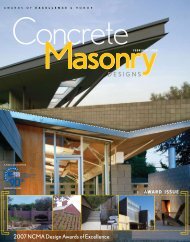to view article - Sutter Masonry
to view article - Sutter Masonry
to view article - Sutter Masonry
Create successful ePaper yourself
Turn your PDF publications into a flip-book with our unique Google optimized e-Paper software.
for redundancy of protection, also known as a "belt andsuspenders" approach.This TEK provides a brief over<strong>view</strong> of the issues <strong>to</strong>consider when designing single wythe walls for waterpenetration resistance. The information presented is notmeant <strong>to</strong> be comprehensive. Where appropriate, references<strong>to</strong> more detailed sources are provided.SOURCES OF WATER IN WALLSDriving RainAlthough concrete masonry units and mortar generallydo not allow water <strong>to</strong> pass through quickly, raincan pass through if driven by a significant force. Crackscaused by building movements, or gaps between masonryand adjoining building elements are common points ofwater entry. If rain enters a wall other than by way of theroof or at element interfaces (such as penetrations andwindow openings), it often can be traced <strong>to</strong> the masonryunit-mortar interface.Capillary ActionUntreated masonry materials (without a compatibleintegral water repellent and/or post-applied surfacetreatment) typically take on water through absorption,adsorption and/or capillary forces. The amount of waterdepends on the characteristics of the masonry and mortar.Integral water repellents greatly reduce the absorptionand adsorption characteristics of the units and mortar,but may not be able <strong>to</strong> prevent all moisture migration ifthere is a significant head pressure of approximately 2 in.water (51 mm) or more. Post-applied surface treatmentsreduce moisture penetration of masonry at the treatedsurface as well, but have little effect on the interior ofthe units.Water VaporWater as vapor moves through a wall either via airleakage or by diffusion (from higher <strong>to</strong> lower: relativehumidity, pressure and/or temperature). As air cools, itbecomes more saturated, and when it reaches the dewpoint temperature the water vapor will condense in<strong>to</strong>liquid form. See the Condensation Control section onpage 7 for more information.Ground WaterProtecting below-grade walls from water entryinvolves installing a barrier <strong>to</strong> water and water vapor.Below grade moisture tends <strong>to</strong> migrate from the dampsoil <strong>to</strong> the drier area inside the basement. An imperviousbarrier on the exterior wall surface can prevent moistureentry. The barrier is part of a comprehensive system <strong>to</strong>prevent water penetration, which includes proper wallconstruction and the installation of drains, gutters, andproper grading (location of finished grade as well as gradesloping away from the building). Landscaping can alsocontribute <strong>to</strong> water ponding adjacent <strong>to</strong> the foundationwall and/or <strong>to</strong> insufficient drainage. IBC Section 1805contains requirements for dampproofing and water proofingfoundations. More detailed information for concretemasonry foundation walls can be found in PreventingWater Penetration in Below-Grade Concrete <strong>Masonry</strong>Walls, TEK 19-3A (ref. 2).DESIGN CONSIDERATIONSWhen designing for moisture mitigation in walls,three levels of defense should be considered: surfaceprotection (properly constructed mortar joints, surfacewater repellents, surface coatings), internal protection(integral water repellents), and drainage/drying (flashing,weeps, vents). The most successful designs oftenprovide redundancy among these three levels. Thisredundant design approach helps ensure that the wallremains free of moisture problems even if one of thedefense mechanisms is breached. Flashing and weeps,for example, provide a backup in case surface coatingsare not reapplied as needed or leaks develop around windowsor other openings. The following sections discussthe individual mechanisms in more detail.Physical Characteristics of the UnitsOpen-textured concrete masonry units possessinglarge voids tend <strong>to</strong> be more permeable than closedtexturedunits. The texture can be affected by aggregategradation, water content of the concrete mix, amoun<strong>to</strong>f cement in the mix, other materials in the mix suchas admixtures, and the degree of compaction achievedduring molding. These fac<strong>to</strong>rs can also affect capillaryaction and vapor diffusion characteristics. Units shouldbe aged at least 21 days if possible before installation <strong>to</strong>reduce the chance of shrinkage cracks at the mortar-unitinterface.Smooth-faced units facilitate mortar joint <strong>to</strong>oling,so will generally result in a more water resistant wall, asopposed <strong>to</strong> fluted units which are more difficult <strong>to</strong> <strong>to</strong>oland therefore the most susceptible <strong>to</strong> leakage. Horizontaleffects such as corbels and ledges that may hold waterare more prone <strong>to</strong> water penetration.Integral Water RepellentsThe use of integral water repellents in the manufactureof concrete masonry units can greatly reducethe wall's absorption characteristics. When using unitswith an integral water repellent, the same manufacturer'swater repellent for mortar must be incorporated in the2 NCMA TEK 19-2B



